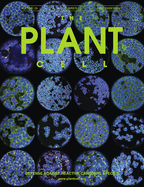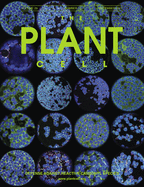
Cover image

Methylglyoxal and glyoxal are toxic reactive carbonyl species generated as by-products of glycolysis. The preemption pathway for detoxification of these products is the glyoxalase (GLX) system, involving reactions catalyzed by GLXI and GLXII. In Arabidopsis, the GLX system is encoded by three homologs each of GLXI and GLXII, from which several isoforms are derived through alternative splicing. Schmitz et al. (pages
Volume 29, Issue 12, December 2017
EDITORIAL
Thank You, Editors and Reviewers of The Plant Cell
IN BRIEF
Open-Source Device Tracks Mechanical Properties of Living Plant Cells in 3D
Epitranscriptomics and Flowering: mRNA Methylation/Demethylation Regulates Flowering Time
Life's a Gas under Pressure: Ethylene and Etioplast Maintenance in Germinating Seedlings
Manganese Is a Plant's Best Friend: Intracellular Mn Transport by the Transporter NRAMP2
Guarding the Gates: How PROCERA Helps Keep Tomato Plants from Wilting
Granting an Extension: Phosphorylation of the Pol II CTD Regulates mRNAs Produced by Read-Through from Small Nuclear RNAs
BREAKTHROUGH REPORT
An Automated Confocal Micro-Extensometer Enables in Vivo Quantification of Mechanical Properties with Cellular Resolution
A method of measuring the mechanical properties of cells in living plant tissues in the direction of growth while simultaneously gathering confocal images reveals spatial gradients in extensibility.
RESEARCH ARTICLES
Patterns and Consequences of Subgenome Differentiation Provide Insights into the Nature of Paleopolyploidy in Plants
Coordinated genetic and epigenetic differentiation of duplicate genes in ancient polyploids is common in genomes with and without biased fractionation.
ALKBH10B Is an RNA N 6-Methyladenosine Demethylase Affecting Arabidopsis Floral Transition
Arabidopsis ALKBH10B is a major m6A mRNA demethylase affecting floral transition and vegetative growth.
Arabidopsis Pollen Fertility Requires the Transcription Factors CITF1 and SPL7 That Regulate Copper Delivery to Anthers and Jasmonic Acid Synthesis
Transcription factors CITF1 and SPL7 regulate the delivery of a micronutrient copper to anthers, thereby influencing fertility, and link copper homeostasis and the jasmonic acid metabolic pathway.
MAPKs Influence Pollen Tube Growth by Controlling the Formation of Phosphatidylinositol 4,5-Bisphosphate in an Apical Plasma Membrane Domain
The production of regulatory membrane phospholipids required for polar tip growth of pollen tubes is controlled by mitogen-activated protein kinases.
EIN3 and PIF3 Form an Interdependent Module That Represses Chloroplast Development in Buried Seedlings
The EIN3-PIF3 pair functions as a central integrator of multiple signals for the concerted repression of chloroplast development in soil.
Intracellular Distribution of Manganese by the Trans-Golgi Network Transporter NRAMP2 Is Critical for Photosynthesis and Cellular Redox Homeostasis
The metal transporter NRAMP2 controls photosynthesis and antioxidant defenses by releasing manganese from the trans-Golgi network, thus building up a cytosolic pool that feeds downstream organelles.
Shine-Dalgarno Sequences Play an Essential Role in the Translation of Plastid mRNAs in Tobacco
Genome-wide analysis sheds light on the dependence of plastid translation on interactions between Shine-Dalgarno-like sequences in mRNA and the anti-Shine-Dalgarno sequence in 16S ribosomal RNA.
DISTAG/TBCCd1 Is Required for Basal Cell Fate Determination in Ectocarpus
Mutations in Ectocarpus DISTAG, which encodes a TBCCd1 protein, disrupt the subcellular architecture in the germinating initial cell leading to loss of all basal structures from the developing alga.
CORTICAL MICROTUBULE DISORDERING1 Is Required for Secondary Cell Wall Patterning in Xylem Vessels
A novel microtubule-associated protein is required for the pitted secondary cell wall patterning in xylem vessels.
Differential Regulation of Two-Tiered Plant Immunity and Sexual Reproduction by ANXUR Receptor-Like Kinases
ANXUR receptor-like kinases regulate two-tiered plant immunity by association with pattern recognition receptor and NLR protein complexes.
The Coiled-Coil and Nucleotide Binding Domains of BROWN PLANTHOPPER RESISTANCE14 Function in Signaling and Resistance against Planthopper in Rice
The coiled-coil and nucleotide binding domains of BROWN PLANTHOPPER RESISTANCE14 interact with WRKY transcription factors to activate defense signaling and confer resistance to planthopper attack.
The Tomato DELLA Protein PROCERA Acts in Guard Cells to Promote Stomatal Closure
The tomato DELLA protein PROCERA, a negative regulator of gibberellin signaling, increases the sensitivity of guard cells to abscisic acid, leading to stomatal closure and increased drought tolerance.
Genetic Components of Root Architecture Remodeling in Response to Salt Stress
Natural variation in 347 Arabidopsis accessions reveals differential root plasticity responses to salinity, associated with 100 genetic loci, and roles for HKT1 and CYP79B2 in lateral root development.
Salt Stress and CTD PHOSPHATASE-LIKE4 Mediate the Switch between Production of Small Nuclear RNAs and mRNAs
Salt stress and Pol II-CTD phosphorylation status affect switching between normal snRNA/imRNA production and biogenesis of stress-specific mRNAs derived from 3′-elongated snRNAs/ncRNAs.
Defense against Reactive Carbonyl Species Involves at Least Three Subcellular Compartments Where Individual Components of the System Respond to Cellular Sugar Status
Detoxification of reactive carbonyl species produced by enhanced cellular sugar levels involves at least three subcellular compartments and depends on a specific glyoxalase I isoform during germination.
Increased Phosphorylation of Ser-Gln Sites on SUPPRESSOR OF GAMMA RESPONSE1 Strengthens the DNA Damage Response in Arabidopsis thaliana
The number of phosphorylated sites on transcription factor SOG1 affects the strength of various DNA damage responses including DNA repair, replication arrest, cell death, and cell differentiation.
Mediator Complex Subunits MED2, MED5, MED16, and MED23 Genetically Interact in the Regulation of Phenylpropanoid Biosynthesis
The effects of a semidominant MED5b mutant on phenylpropanoid metabolism and/or growth are suppressed by mutation of MED2, MED16, or MED23.


